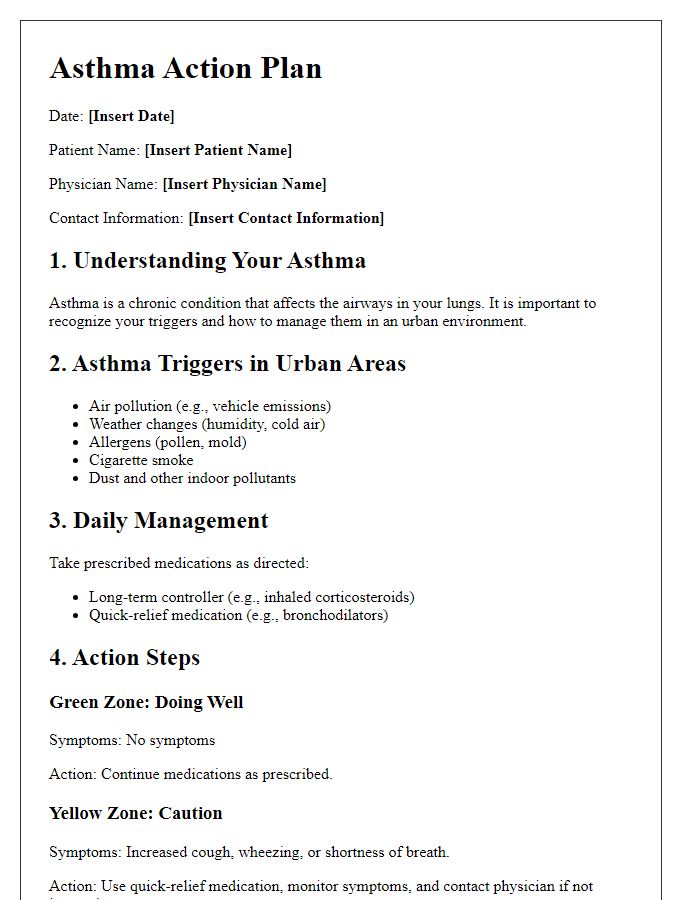Creating personalized asthma care plans is crucial for managing this chronic condition effectively. These plans not only help patients understand their triggers but also empower them to take charge of their health. With tailored strategies and tools, individuals can navigate their asthma with confidence and ease. Ready to learn how to craft the perfect asthma care plan? Keep reading!

Patient's personal information and medical history
Creating a personalized asthma care plan is essential for managing asthma effectively. The plan typically includes the patient's personal information, such as full name, date of birth, and contact details. Medical history highlights previous asthma episodes, including frequency and severity (e.g., hospitalizations, emergency room visits). Specific triggers (common allergens like pollen, dust mites, or pet dander) should be noted. Medications prescribed (e.g., inhalers like Albuterol for quick relief, corticosteroids for long-term control) are listed along with dosages and schedules. A self-monitoring action plan outlines peak flow meter readings (measured in liters per minute) and corresponding symptoms, guiding patients on when to seek medical attention. Emergency contact information, including the primary physician's name and phone number, reinforces support available for urgent situations.
Detailed asthma triggers and symptoms
Personalized asthma care plans outline specific asthma triggers, which vary by individual. Common triggers include environmental factors such as seasonal pollen (grass, tree, ragweed), which peaks in spring and fall, pet dander from cats or dogs, smoke from cigarettes or wood-burning stoves, and chemicals found in household cleaners. Weather changes, particularly cold air or humidity, can provoke symptoms like wheezing, coughing, or shortness of breath. Physical activities such as running or vigorous exercise, especially in cold weather, also pose risks. Additionally, respiratory infections, commonly caused by viruses such as the flu or common cold, frequently exacerbate asthma symptoms. Tracking these triggers, along with understanding personal symptoms and peak flow measurement (usually between 300-600 liters per minute for adults), leads to more effective management of asthma and can help prevent severe asthmatic episodes.
Personalized medication regimen and instructions
Personalized asthma care plans include detailed medication regimens designed to manage symptoms effectively. Inhaled corticosteroids, such as Fluticasone (common dosage levels of 44-220 mcg), are often prescribed to reduce inflammation in the airways. Short-acting beta-agonists, like Albuterol, may be recommended as rescue inhalers, typically dosed at 90-180 mcg for immediate relief of acute symptoms. Patients should receive clear instructions on medication use, which include proper inhalation techniques (such as using a spacer for enhanced delivery) and the importance of adherence to prescribed routines. Regular follow-up appointments (usually every six months) should be scheduled to monitor progress and adjust medications as necessary, enhancing overall asthma management.
Emergency contact and action plan
A personalized asthma care plan encompasses essential guidelines for managing asthma symptoms effectively, featuring an emergency contact section and a detailed action plan. Emergency contacts must include names, phone numbers, and relationships of individuals such as family members or caregivers, ensuring rapid assistance during an asthma attack. The action plan outlines steps to take based on symptoms, categorized as mild, moderate, or severe, with visual aids such as colored zones (green, yellow, red) indicating varying levels of severity. Key medications like bronchodilators or corticosteroids should be clearly listed alongside dosages and administration methods, providing clarity in urgent situations. Additionally, incorporating environmental factors, such as identified allergens like pollen and pet dander, can further enhance asthma management strategies within the plan.
Routine monitoring and follow-up schedule
Routine monitoring of asthma management includes regular assessments of peak flow measurements and symptom diaries. Peak flow meters, devices that measure exhaled air, should be used daily to track lung function. A follow-up schedule typically involves consultations every three months to adjust medication based on control levels, usually outlined during visits to healthcare professionals specialized in respiratory conditions. During these appointments, clinicians may review adherence to prescribed inhalers, evaluate the effectiveness of the action plan, and provide education on recognizing and managing triggers (such as pollen, pet dander, or smoke) that lead to exacerbations. Establishing a clear communication channel with healthcare providers can facilitate timely interventions, ensuring optimal management of asthma symptoms. Alerts for hospital visits and emergency action plans should be clearly outlined for unexpected asthma attacks.
Letter Template For Personalized Asthma Care Plans Samples
Letter template of focused asthma care recommendations for rural settings.

Letter template of collaborative asthma care plan for family involvement.











Comments